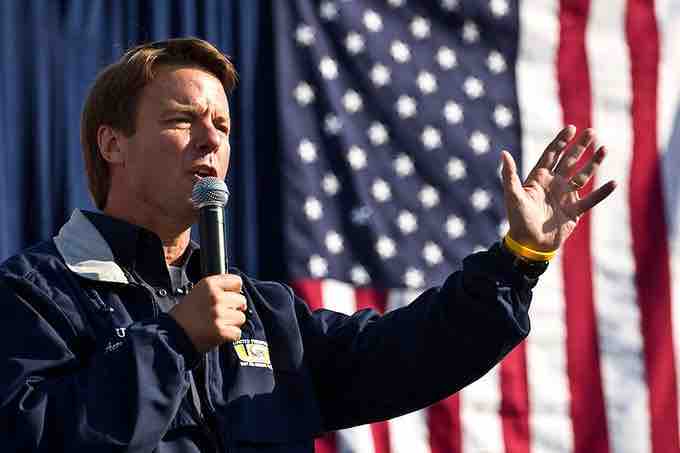Introduction
A political campaign is an organized effort which seeks to influence the decision making process within a specific group. In democracies, political campaigns often refer to electoral campaigns, where representatives are chosen or referendums are decided . In modern politics, the most high profile political campaigns are focused on candidates for head of state or head of government, often a President or Prime Minister.

Candidate for Congress
Walter Faulkner, candidate for U.S. Congress, campaigning with a Tennessee farmer. Crossville, Tennessee.
Background History
Political campaigns have existed as long as there have been informed citizens. The phenomenon of political campaigns are tightly tied to lobby groups and political parties. The first modern campaign is thought to be William Ewart Gladstone's Midlothian campaign in the 1880's, although there may have been earlier modern examples from the 19th century. American election campaigns in the 19th century created the first mass-base political parties and invented many of the techniques of mass campaigning.
Process of Campaigning
Major campaigns in the United States are often much longer than those in other democracies. Campaigns start anywhere from several months to several years before election day. Once a person decides to run, they will make a public announcement. This announcement could consist of anything from a simple press release to concerned media outlets to a major media event followed by a speaking tour. It is often well-known to many people that a candidate will run prior to an announcement being made .

John Edwards Pittsburgh 2007
2008 United States Presidential candidate John Edwards campaigning in Pittsburgh on Labor day in 2007, accepting the endorsement of the United Steelworkers and the United Mine Workers of America.
Campaigns often dispatch volunteers into local communities to meet with voters and persuade people to support the candidate. The volunteers are also responsible for identifying supporters, recruiting them as volunteers or registering them to vote if they are not already registered. The identification of supporters will be useful later as campaigns remind voters to cast their votes . Late in the campaign, campaigns will launch expensive television, radio, and direct mail campaigns aimed at persuading voters to support the candidate. Campaigns will also intensify their grassroots campaigns, coordinating their volunteers in a full court effort to win votes.
Nixon Meets Crowds at Robins Air Force Base in Georgia
President Nixon "works the crowd" at Robins Air Force Base, Georgia in the initial stages of his campaign.
Campaign Finance in the United States
Campaign finance in the United States is the financing of electoral campaigns at the federal, state, and local levels. At the federal level, campaign finance law is enacted by Congress and enforced by the Federal Election Commission (FEC), an independent federal agency. Although most campaign spending is privately financed, public financing is available for qualifying candidates for President of the United States during both the primaries and the general election. Eligibility requirements must be fulfilled to qualify for a government subsidy, and those that do accept government funding are usually subject to spending limits.
In 2008—the last presidential election year—candidates for office, political parties, and independent groups spent a total of $5.3 billion on federal elections. The amount spent on the presidential race alone was $2.4 billion, and over $1 billion of that was spent by the campaigns of the two major candidates: Barack Obama spent $730 million in his election campaign, and John McCain spent $333 million. The total spent on federal elections in 2012 was approximately $7 billion. The figures for the 2016 election will not be available until 2017.
Techniques
A campaign team must consider how to communicate the message of the campaign, recruit volunteers, and raise money. Campaign advertising draws on techniques from commercial advertising and propaganda. The avenues available to political campaigns when distributing their messages is limited by the law, available resources, and the imagination of the campaigns' participants. These techniques are often combined into a formal strategy known as the campaign plan. The plan takes account of a campaign's goal, message, target audience, and resources available. The campaign will typically seek to identify supporters at the same time as getting its message across.
Modern Technology and the Internet
The internet is now a core element of modern political campaigns. Communication technologies such as e-mail, web sites, and podcasts for various forms of activism to enable faster communications by citizen movements and deliver a message to a large audience. These Internet technologies are used for cause-related fundraising, lobbying, volunteering, community building, and organizing. Individual political candidates are also using the internet to promote their election campaign.
Signifying the importance of internet political campaigning, Barack Obama's presidential campaign relied heavily on social media, and new media channels to engage voters, recruit campaign volunteers, and raise campaign funds. The campaign brought the spotlight on the importance of using internet in new-age political campaigning by utilizing various forms of social media and new media (including Facebook, YouTube and a custom generated social engine) to reach new target populations. The campaign's social website, my.BarackObama.com, utilized a low cost and efficient method of mobilizing voters and increasing participation among various voter populations. This new media was incredibly successful at reaching the younger population while helping all populations organize and promote action.